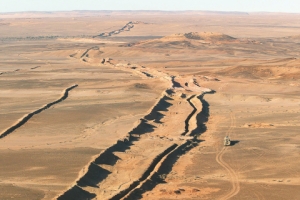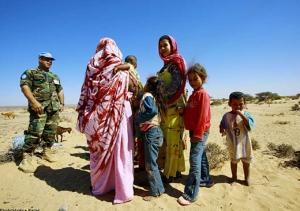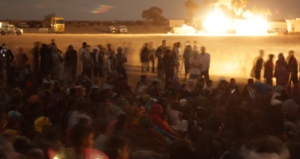The world has changed in many ways in the past 50 years. Global population has doubled, and well over half of the people alive in the world today were born after the United Nations requested, in 1965, that Spain de-colonise the territory of Western Sahara, which it had occupied since the late 19th century. But Spain would not relinquish the last colonial country in Africa so readily, and for the next 7 years the request for Spain to organise a referendum to establish the will of the people with regard to the future of Western Sahara was an annual fixture on the UN agenda.
To break out of this state of political limbo required more than a yearly repetition of the referendum request. The POLISARIO (Frente Para la Liberación de Saguia Al Hamra y Rio de Oro) was established in 1973 to force a change in tempo, by voicing the demands of the Saharawi and confronting the Spanish military. The initial impact seemed promising: the following year the first census was conducted and hopes began to rise that a lasting solution for independence was at hand. Those hopes evaporated as neighbouring Mauritania and Morocco replaced Spain as occupiers in 1976, and began a military pincer movement against the Saharwi. Increasingly, local inhabitants were driven into desert regions or to Algeria as refugees, victims of ambitious geopolitical competition between Morocco, which continues to uphold its territorial claims, and Mauritania, which eventually relinquished and withdrew.
And that is where we find the Saharwi today. Trapped in the sand behind a gigantic berm 2,700 kilometers long, laced with unknown thousands of landmines, heavily guarded by an estimated 100,000 Moroccan troops, with UN peacekeeping force MINURSO deployed to ensure the 1991 ceasefire agreement is upheld. Despite voting in favour of it, the Kingdom of Morocco has still not acceded to the Mine Ban Treaty and, while both sides have agreed to cooperate with MINURSO to identify and remove mines and other unexploded ordnance, the berm is not included in the agreement. All major settlements, including the capital, are on the side occupied by Morocco, which encourages settlers and enters into trading agreements for Western Saharan resources such as phosphates, oil, fisheries, and even the sand. Goods produced in the occupied territory are regularly discovered being mislabelled “Made in Morocco”. All of these infractions are vigorously denounced by activists, with some notable successes in recent years.
On the other side of this monstrous wall the Saharwi wait to reclaim their rights, while their resources are plundered. They live on the goodwill of others, humanitarian assistance and charitable donations, while the wealth of their land lines the coffers of Morocco. It is estimated that between 90,000 and 165,000 people are living in the 5 camps they created over thirty years ago, when they fled the fighting. A reliable population census would facilitate the referendum these people were promised, which explains the wide gap between the lower estimate from Morocco and the upper estimate from the Saharwi. They didn’t expect to be living in these camps for so many years, decades even. Some of them have family on the other side of the barrier they have not seen for 30 years. MINURSO tries to arrange reunions, but the list is long and only a few people at a time can be granted this brief respite.
The record of human rights abuse against the Saharwi is appalling, including aerial bombardment, the use of white phosphorous, arbitrary detention, torture, persecution, and rape. Although this situation has existed for many years, the UN envoy requested an extension of MINURSO’s mandate after the brutal repression of a mass demonstration and sit-in at Laayoune on 10 November 2010. Some keen-eyed observers have labeled this event as the true beginning of the uprisings that have engulfed the region since then, the so-called “Arab Spring”. After a two-year delay, Saharwi activists were given sentences ranging between 20 years and life in a military trial, condemned by Amnesty International as “flawed from the outset.” The protests, and the military repression against them, continue. The UN mission is not documenting human rights abuses in Western Sahara, so activists have created their own crowdsource space to gather reports and evidence.
Most fascinating, that in this desert wilderness against a backdrop of despair, democracy has bloomed. The POLISARIO has a functioning government supported by local committees, and a refreshingly progressive attitude towards equality and discrimination on gender, education, disability, and religion. Communities had no choice but to adapt to develop, improving in stages with each successive generation of these fiercely independent and strong-willed people. As often happens under extreme hardship and oppression, creative pursuits, especially music and community events, play a very important role in Saharwi culture. One of the best-known musical artists, Mariem Hassan, is welcomed around the world. This October, a repeat of the hugely successful FiSahara Film Festival is planned. The project is run by the Spanish Network of Organizations in Solidarity with the Western Sahara (CEAS), a non-profit NGO based in Spain with humanitarian projects in the Saharwi refugee camps. Organisers are currently processing registrations, and making arrangements to house visitors with refugee families from 8 to 13 October in the Tindouf camp. They are looking for volunteers to help with everything from maintaining the website to promoting the event.
How much longer can this situation endure? With the increasing availability of the internet facilitating information sharing, and the development of online social and support networks, the story of the Saharwi is beginning to spread despite these long years of ignorance, and Morocco’s determination to suppress information. Those monitoring the situation in Mali also have a wary eye on Western Sahara, and some analysts probe the possible dynamics of relationships between the POLISARIO rebels, the MNLA, and sundry Islamist groups currently occupying large areas of northern Mali, especially as the 3 aid workers kidnapped from the Tindouf camp in October 2011 were in the hands of such groups. As Saharwi youth become increasingly frustrated with the status quo, some feel the time is right for a change, even breaking the truce, if the UN can’t get its act together and force a referendum in the very near future. This makes them a choice target for recruitment by the rebel gangs who support their antics by trafficking people, drugs, contraband, and weapons across the Sahel region.
Related articles
- Finding Permanent Solution To Western Sahara conflict – UN (spyghana.com)
- Western Sahara: Human rights in the occupied Western Sahara (ionglobaltrends.com)
- Behind the protests in Western Sahara (dailystar.com.lb)
- Roundtable Introduction: Beyond Dominant Narratives on the Western Sahara (jadaliyya.com)
- The Last Colony: Photo Essay on Western Sahara (jadaliyya.com)
- Gallery by photojournalist Paulo Nunes dos Santos “Sahrawi: Maghreb’s forgotten refugees“
Filed under: Algeria, Human Rights, Mauritania, Morocco, Spain, Updates, Western Sahara Tagged: Africa, Morocco, Polisario Front, Spain, United Nations, Western Sahara
via @lissnup on WordPress




No comments:
Post a Comment
Note: only a member of this blog may post a comment.